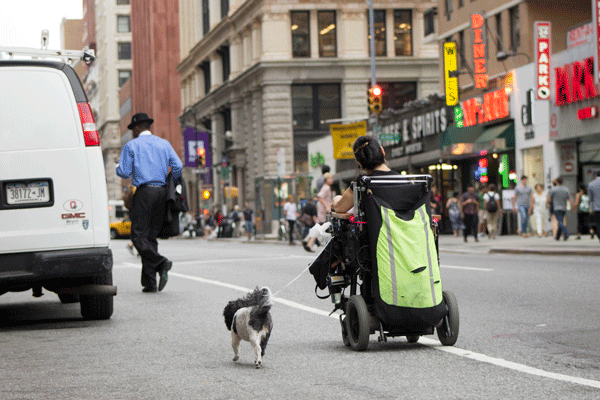
BY ZACH WILLIAMS | Disability activists received unanimous support from the Community Board 3 Transportation Committee for a class-action lawsuit seeking to force the city Department of Transportation to repair thousands of sidewalks and curb ramps in Lower Manhattan.
The suit alleges that the city has ignored requests from the Center for Independence of the Disabled New York to address alleged violations of both the Americans with Disabilities Act and the New York City Human Rights Law. While the problems are citywide, the predominance of government buildings in Lower Manhattan prompted activists to focus on this area, Julia Pinover-Kupiec — an attorney for Disability Rights Advocates, which sued in U.S. District Court on July 30 — told the committee.
The situation in Manhattan below 14th St. is “more important and it’s worse, and that is why I’m here,” she told C.B. 3 members at the Sept. 4 meeting.
“I don’t think the city has been acting in good faith for a decade,” said committee member David Crane, who wondered whether the suit’s allegations were strong enough.
A letter sent on May 30 about the issue did not receive a response, Pinover-Kupiec said later. D.O.T. met with activists in July after a second effort, but would not agree to enter into “structured settlement negotiations to discuss” how to resolve issues or make suggested improvements over “a reasonable period of time,” according to the lawsuit.
The plaintiffs include two disabled people and CIDNY. This reporter’s sister works at CIDNY but is not involved in the suit. The city, D.O.T. and Polly Trottenberg, the agency’s commissioner, are listed as defendants in the suit.
The lawsuit’s endorsement by C.B. 3 paves the way for hopefully garnering the same from neighboring Boards 1 and 2, as well as increasing public pressure on D.O.T. to address the issues, according to Pinover-Kupiec.
According to CIDNY, more than 75 percent of 1,066 surveyed curbs had barriers presenting safety hazards to people with mobility or vision disabilities. Almost one-quarter of the curbs had no curb ramps at all, according to the survey.
A D.O.T. spokesperson said that 89 percent of street corners in C.B. 2 and 3 had pedestrian ramps installed. Data for C.B. 1 was unavailable, he said, due to “a great deal of capital construction” there.

















